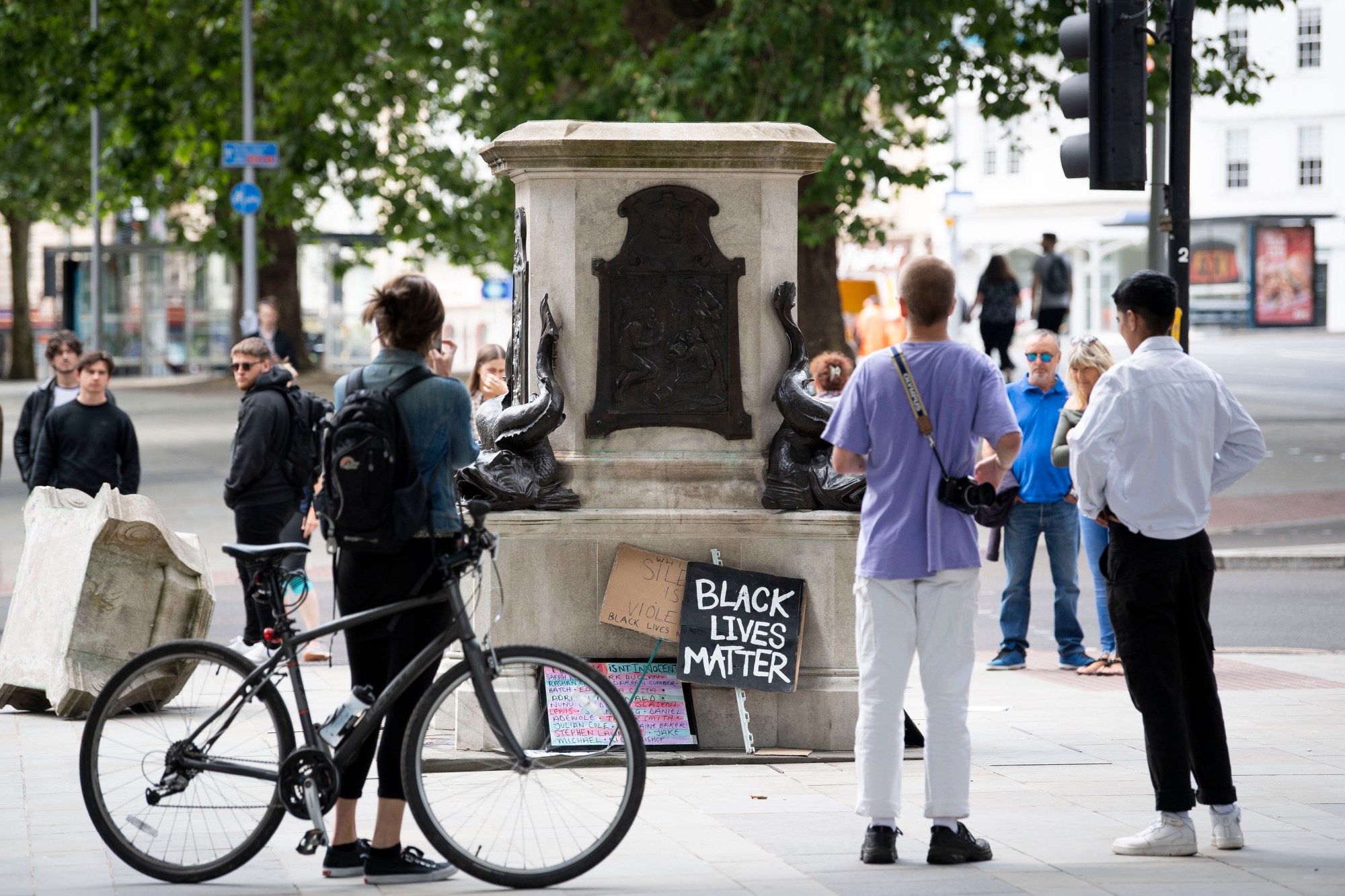In the British imagination, racism is something that happens in other places. As the Black Lives Matter protests sweeping America made their way to the UK, Emily Maitlis suggested in a Newsnight segment with George The Poet that our legacy of slavery is “not the same” as America’s, despite America’s slave trade emerging while under British rule — not to mention Britain’s personal history of working enslaved Africans to death on Caribbean plantations. Meanwhile, right-wing commentators lamented a protest based on a cause from abroad, as though people weren’t protesting Britain’s own racist record too.
Politics, it seems, is most comfortably viewed from a distance. The 2003 toppling of Saddam Hussein’s statue in far-off Iraq, for example, was seen as an expression of hard-won democracy after years of tyranny; a reason for Britain to celebrate. Seventeen years later and 3,500 miles closer, the destruction of 17th-century slave trader Edward Colston’s statue in Bristol over the weekend has engendered a different response. Labour leader Keir Starmer lamented the statue’s existence but said that it was “completely wrong” for protesters to pull it down, while Tory housing minister Kit Malthouse suggested that “democratic means” should have been used to bring about the effigy’s demise. Others wheel out the old “preserving history” line, as though toppling a statue is somehow less historic than erecting one.
When Saddam’s statue fell, we could explore what it said about his legacy, and indeed the society that produced him, without threatening our own national sense of self. But when those same questions are asked of a man whose name is virtually omnipresent in a British city, despite him bearing direct responsibility for the deaths of at least 19,000 people and the enslavement of many more, the nearness of it all becomes suffocating for those who are uncritically invested in Britishness, and ignorant of the contemporary struggles faced by descendants of enslaved Africans in the UK and elsewhere. Toppling statues reminds us that monuments aren’t just reflective of decisions made in the past. They also say something about the culture that allows them to continue existing in the present day. If Saddam’s statue was a symbol of change, we can interpret the backlash against Colston’s toppling as a backlash to change.
While (allegedly) occupying different ends of the political spectrum, Starmer and Malthouse are united in the belief that to achieve progress Black people should surrender to the democratic process. But this is predicated on the assumption that Black people and white people are able to access democracy in equal ways. History teaches us otherwise.
Based on Britain’s last three general elections, if Black and Minority Ethnic (BAME) voters were the majority, we would be living in a very different Britain. In 2019, Labour won the votes of 64% oof the BAME electorate, while the Tories earned just 20%. Similar voting patterns among BAME groups were seen in 2017 and 2015.
Interestingly, in 2019, Labour’s vote share among BAME groups was considerably larger than any overall general election consensus in recent years; despite the Tories gaining the highest GE vote share of any political party since 1979, they still only earned a relatively paltry 43.6% of votes. In 2019, as Black Britain rallied around Jeremy Corbyn, everyone else decided to vote in a way that allowed a man with a long history of making anti-Black comments to become Prime Minister. The data tells us that Black people’s political hopes hinge on the grace of white voters. In Britain, Black people could never possess such power over our white counterparts. With all that in mind, I’d hesitate to call what Black people experience in the UK, America, and wherever else we exist as a racialised minority, ‘democracy’.
Calls to respect the ‘democratic process’ also ignore that it has achieved very little, as far as Colston’s legacy is concerned. In 2018-19, a year-long back and forth between different counsellors, MPs and other political figures over the wording on a plaque intended to reveal Colston’s links to the slave trade resulted in no plaque at all. The statue came down only after democratic processes were exhausted.
I am reminded of the recently freed black Jamaicans in Jean Rhys’ Wide Sargasso Sea, who burn down the childhood home of the novel’s main character Antoinette. To her and her white-Creole family, the fire is a destructive force from an “angry mob”. But we should also think of fire from the perspective of brutalised former slaves. We have to consider fire and other forms of destruction as a means of purification, a necessary preparation for new growth. Colston’s statue has revealed that the difference in perspective between Antoinette’s former-slaver family and angry former slaves is still alive today. Some of us view Colston’s statue toppling as a symbolic purification, while for others it’s simply vandalism. Hiding behind the language of ‘lawfulness’, as politicians on both sides have done, doesn’t allow space for such vandalism to be righteous.
Martin Luther King Jr said that a riot is “the language of the unheard”, and his sentiment applies to all sorts of unlawful political action, including the toppling of statues. Such action is necessary for societies where both democratic mechanisms and demographic realities neuter the political hopes of minorities. If slavery and colonialism were once lawful, how can politicians be so sure in their condemnation of lawlessness? More importantly, how can we trust politicians to make the distinction?


